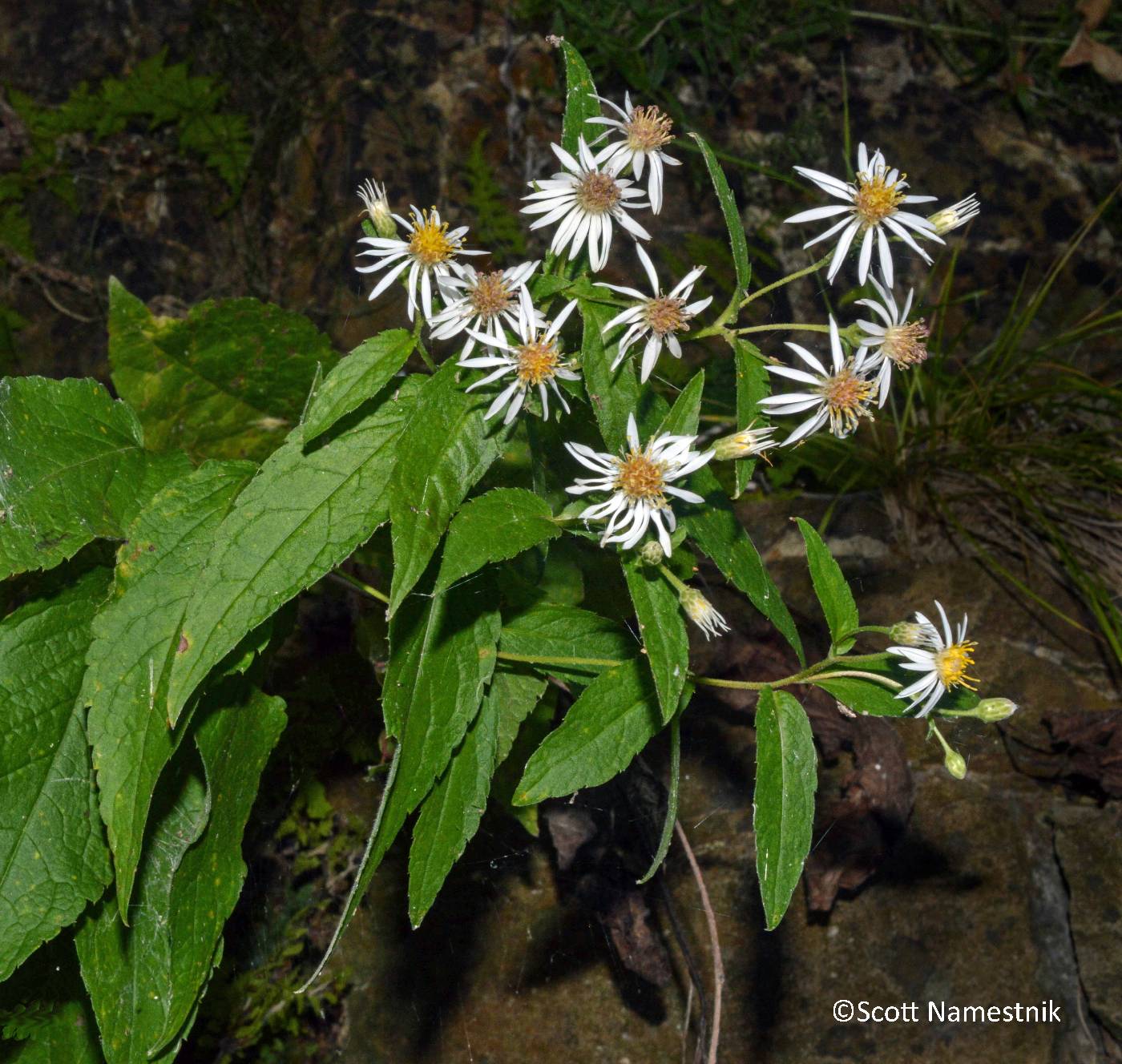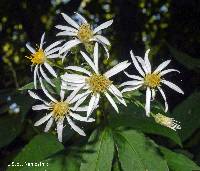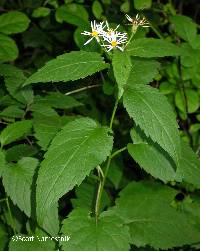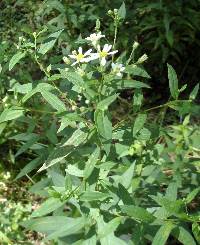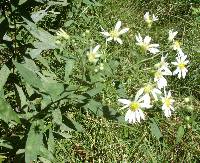
|
|
|
|
Family: Asteraceae
Forked Wood-Aster, more...forked aster
[Aster furcatus Burgess, moreAster furcatus f. erythractis Benke, Aster furcatus var. elaciniatus Benke] |
Plants (30-)50-120 cm; strongly in clones or scattered clumps, eglandular; rhizomes elongate, fleshy. Stems 1-5+, erect, simple, ± flexuous distally (± ridged from decurrent leaf bases), glabrate proximally, sparsely villous distally. Leaves basal and cauline (grayish green abaxially), bases often oblique, margins serrate, veins prominent, abaxial faces scabrous, adaxial hirsute; basal and proximal cauline withering by flowering (rosettes produced in late season, absent in spring), short-petiolate, petioles winged, sheathing, blades ovate-lanceolate, 40-130 × 20-90 mm, bases rounded to subcordate, apices obtuse to acute; mid short-petiolate, narrowly winged, wings revolute, bases dilated, sheathing, ciliate, blades ovate to lance-ovate, 100-120(-150) × (30-)60-80 mm, gradually reduced distally, bases shallowly cordate or truncate to rounded, margins sharply serrate, teeth mucronate, apices acuminate; distal (arrays) subpetiolate or sessile, ovate, 8-70 × 4-23 mm, bases sheathing or clasping. Heads 4-32+ in flat-topped, corymbiform arrays. Peduncles 0.5-3(-5) cm, villous; bracts 0-3. Involucres campanulate, 6-8(-10) mm, much shorter than pappi. Phyllaries ca. 40 in 5 series, oblong (outer) to linear-lanceolate (inner), strongly unequal, membranous, bases indurate and low-keeled or rounded abaxially, green zones in distal 1 / 4 - 1 / 3 , obovate, poorly defined, margins hyaline, scarious, villoso-ciliate, inner often purplish, apices appressed, obtuse to rounded, faces villous, eglandular. Ray florets (12-)15-20; corollas white, sometimes becoming pink or lavender, 12-18 × 1-2.5 mm. Disc florets 25-35+; corollas cream or light yellow becoming purple, 6-7(-8) mm, slightly ampliate, tubes cylindric, lengths about twice funnelform throats, lobes erect, lanceolate, 0.8-1.2 mm (glabrous). Cypselae brown, fusiform, (2.5-)3-3.5(-4) mm, ribs 8-10(-12), crowded, stramineous to tan, faces ± strigillose; pappi of tawny (apically sometimes clavellate) bristles 6-7 mm, equaling or slightly shorter than disc corollas. 2n = 18. Flowering late Jul-Oct. Calciphile, ± open habitats (± shade intolerant), limestone, sandstone and dolomite areas, mostly n-facing slopes, seepy bluffs, moist deciduous woods, especially along streams, sometimes disturbed sites; 200-600 m; Ark., Ill., Ind., Iowa, Mich., Mo., Wis. D. H. Les et al. (1991b) studied the population genetics of this restricted taxon, and Les et al. (1992) its distribution and autecology in Wisconsin. J. A. Reinartz and D. H. Les (1994) showed that the species is developing self-compatibility in response to small populations. Eurybia furcata is uncommon throughout its range and is considered endangered or threatened in all states where it occurs; it is known only from historic records in Arkansas. It is in the Center for Plant Conservation´s National Collection of Endangered Plants.
Rhizomatous, 3-8 dm, usually without tufts of basal lvs; stem puberulent above; lvs thick and firm, scabrous above, ±densely spreading-hairy across the surface beneath, serrate with mucronulate teeth, the lower petiolate, ovate (often narrowly so), acuminate, with cordate base, 6-15 נ3-8 cm, often deciduous, the middle and upper ones rather gradually reduced, often with winged laciniate petiole, eventually sessile and lanceolate or lance-elliptic; infl corymbiform, flat or round-topped, with few and rather leafy bracts; invol 7-10 mm, its bracts firm, well imbricate, often puberulent, mostly obtuse or rounded, very shortly green-tipped, the outer 1-2 mm wide and not over 2.5 times as long; rays 9-18, white, or becoming lilac or rosy in age, rarely so when young, 8-15 mm; 2n=18. Woods; s. Mich. and s. Wis. to s. Ind. and s. Mo. and nw. Ark. Gleason, Henry A. & Cronquist, Arthur J. 1991. Manual of vascular plants of northeastern United States and adjacent Canada. lxxv + 910 pp. ©The New York Botanical Garden. All rights reserved. Used by permission. From Flora of Indiana (1940) by Charles C. Deam My specimens are from a bluff along Pine Creek in Warren County and from a moist place near Wildcat Creek in Tippecanoe County. Lyon writes that his specimen from Porter County is deposited in the S. F. Blake herbarium. This species is evidently very rare in this state. ...... Indiana Coefficient of Conservatism: C = 10 Wetland Indicator Status: N/A |
This project was made possible in part by the Institute of Museum and Library Services [MG-70-19-0057-19].
Powered by Symbiota

